Beth Kanell's Blog, page 18
December 15, 2014
Things Change: In Small Towns in Vermont, Often via Disaster
When my husband Dave and I began investigating the people and events indicated by an 1880 postcard mailed from one small town near us, to another, I opened up a resource that I'd purchased a few years ago, knowing it would be significant -- but at the time, I'd finished one project related to it, and didn't need the details. It was a doctoral dissertation by Northeast Kingdom historian Allan Yale, and gave details of operations at E. and T. Fairbanks, or, as it was locally called more often, the Mill -- or today, "Fairbanks Scale."
Thanks to Scott Wheeler, editor/publisher of Vermont's Northland Journal, I pulled together all the research around the postcard into a story of discovery, with some suprises in it. And that will be an article in the February issue of Scott's magazine.
I gave to Scott images of the front and back of the postcard. I really wanted to also send along images of a building that has an important role in the story, the company store that the Fairbanks factory operated. But I got frustrated, trying to find a good image. This shows the structure at that location, more or less "today," in brick with the name FAIRBANKS inset up high on the building. But I wasn't sure it fit with the 1880s, and didn't know how to find the right version of the building.
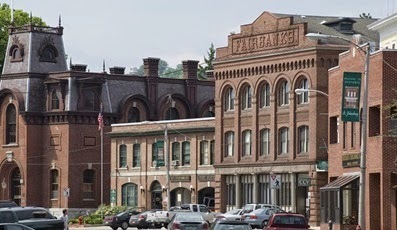 Left to right: St Johnsbury Athenaeum, St. J. Fire Dept., "Fairbanks" building, dental office. Circa 2005.
Left to right: St Johnsbury Athenaeum, St. J. Fire Dept., "Fairbanks" building, dental office. Circa 2005.
Well, you know how "collecting" can be -- my puzzle inspired Dave to keep searching in his own "ephemera" (the fancy name for items that have a very short lifetime, especially old paper). He found a lovely old stapled booklet of photos of the town, and called me to his work space in triumph: there it was, the Fairbanks company store, probably photographed around 1880 to 1900.
But what a difference from today's lineup of structures! In fact, it's clearly made of wood, not brick, and even the "St. Johnsbury House" next door is not the same building we see today.
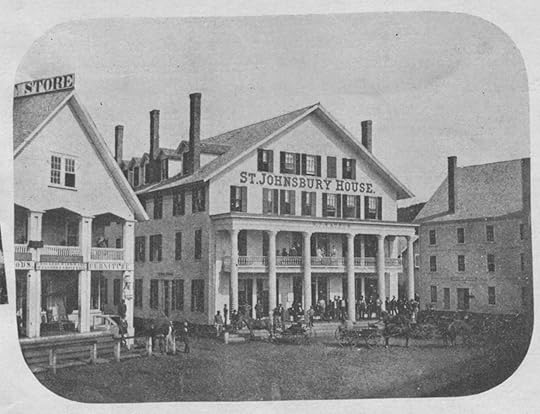 Fairbanks company store, left; St. Johnsbury House, right. 1880-1890?
Fairbanks company store, left; St. Johnsbury House, right. 1880-1890?
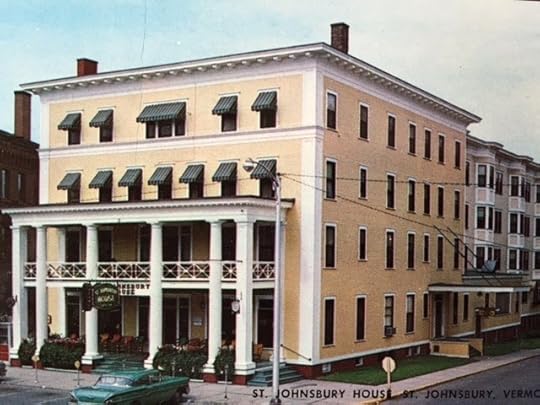 More or less today's St. Johnsbury House. Photo postcard about 1950.What happened?
More or less today's St. Johnsbury House. Photo postcard about 1950.What happened?
Sadly, we know the answer is likely to have been: Fire.
Next task -- find the record of the local disaster that wiped out those earlier structures, and put a date to the change. Even in the past 15 years, St. Johnsbury has seen more than its share of fires in the wooden or wood-framed downtown structures. Someday, the idea of towns that are forced to change via fire, or even via flood (more on that at another time), will seem quaint to us. But today it's still very real. We wish our extended neighborhood a safe winter, and hope this will be a year when fire does not escape its proper place.
Thanks to Scott Wheeler, editor/publisher of Vermont's Northland Journal, I pulled together all the research around the postcard into a story of discovery, with some suprises in it. And that will be an article in the February issue of Scott's magazine.
I gave to Scott images of the front and back of the postcard. I really wanted to also send along images of a building that has an important role in the story, the company store that the Fairbanks factory operated. But I got frustrated, trying to find a good image. This shows the structure at that location, more or less "today," in brick with the name FAIRBANKS inset up high on the building. But I wasn't sure it fit with the 1880s, and didn't know how to find the right version of the building.
 Left to right: St Johnsbury Athenaeum, St. J. Fire Dept., "Fairbanks" building, dental office. Circa 2005.
Left to right: St Johnsbury Athenaeum, St. J. Fire Dept., "Fairbanks" building, dental office. Circa 2005.Well, you know how "collecting" can be -- my puzzle inspired Dave to keep searching in his own "ephemera" (the fancy name for items that have a very short lifetime, especially old paper). He found a lovely old stapled booklet of photos of the town, and called me to his work space in triumph: there it was, the Fairbanks company store, probably photographed around 1880 to 1900.
But what a difference from today's lineup of structures! In fact, it's clearly made of wood, not brick, and even the "St. Johnsbury House" next door is not the same building we see today.
 Fairbanks company store, left; St. Johnsbury House, right. 1880-1890?
Fairbanks company store, left; St. Johnsbury House, right. 1880-1890? More or less today's St. Johnsbury House. Photo postcard about 1950.What happened?
More or less today's St. Johnsbury House. Photo postcard about 1950.What happened?Sadly, we know the answer is likely to have been: Fire.
Next task -- find the record of the local disaster that wiped out those earlier structures, and put a date to the change. Even in the past 15 years, St. Johnsbury has seen more than its share of fires in the wooden or wood-framed downtown structures. Someday, the idea of towns that are forced to change via fire, or even via flood (more on that at another time), will seem quaint to us. But today it's still very real. We wish our extended neighborhood a safe winter, and hope this will be a year when fire does not escape its proper place.
Published on December 15, 2014 07:46
November 26, 2014
Butternuts: A Kitchen Story
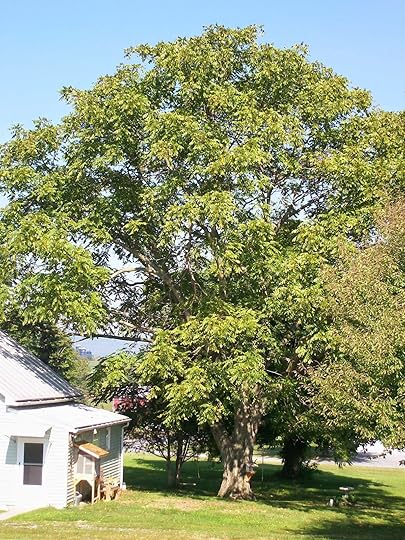 butternut tree
butternut treeWe have an enthusiastic Waterford History group that meets at the local library, the Davies Memorial Library, here in Vermont. Part of our tradition is to consider all of us to be "amateur historians," and we all make discoveries -- in the attic, in old books, behind stone walls suddenly glimpsed through November's bare woods. So each meeting begins with going around the circle, making sure anyone bursting with a new discovery (or, more likely for us, reservedly admitting they've made one) can speak up.
Somehow, last summer, we got onto talking about the old trees that are vanishing. Elms are one of them, of course; every New England town used to have some of these giants, but most were felled by a parasite known as Dutch elm disease, and few remain. Another one (I am sure it was Helen who mentioned it) is the butternut -- and people put their memories and ideas together to talk about where they might have seen a butternut tree in the past decade.
Then, of course, memories of cracking open (actually, smashing with a hammer) the tough nuts came from the oldest among us, who remembered what hard work it was! "I had a recipe for a chocolate butternut cake that was wonderful," Geneva mused. Her relatives asked, "Do you know where it it?" "No," Geneva said with a smile.
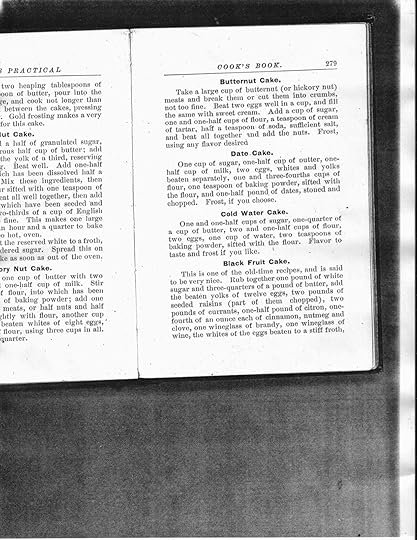 (see top recipe)After the meeting, I went searching for butternuts online, and discovered Native Nuts, a small local firm about an hour away, up by the Canada border (website here). Brigitte at Native Nuts allowed me to reserve two pounds of butternuts from the fall harvest. Then one of Geneva's daughters asked for a two-pound addition. "They should be ready around November first," Brigitte advised.
(see top recipe)After the meeting, I went searching for butternuts online, and discovered Native Nuts, a small local firm about an hour away, up by the Canada border (website here). Brigitte at Native Nuts allowed me to reserve two pounds of butternuts from the fall harvest. Then one of Geneva's daughters asked for a two-pound addition. "They should be ready around November first," Brigitte advised.Next came the recipe question. I didn't find a butternut cake in my own books, so I asked Lois, who has a lot of old recipes from her family. She sent me this one, from Hood's Practical Cook's Book for the Average Household, published around the end of the 1800s. "Add two squares of melted chocolate to turn it into a chocolate cake, she advised.
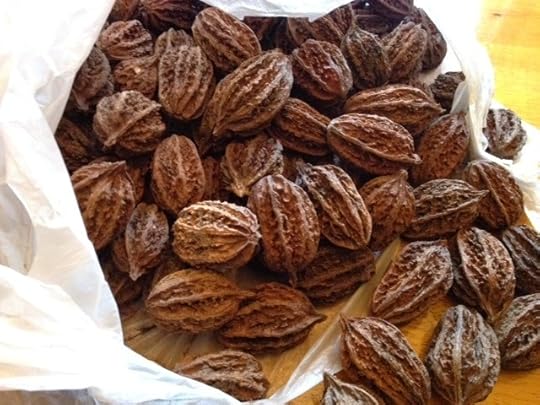 Today the nuts arrived! As soon as you touch one of the ridged, hard, tough exteriors, you understand why they are smashed with hammers, not politely cracked over a bowl. I'm looking forward to trying this, but ... not alone! I'll save my half of the nuts for the next meeting of our history group, which is in February, weather permitting. It clearly takes a village to prepare a cup of butternut nutmeats for this recipe!
Today the nuts arrived! As soon as you touch one of the ridged, hard, tough exteriors, you understand why they are smashed with hammers, not politely cracked over a bowl. I'm looking forward to trying this, but ... not alone! I'll save my half of the nuts for the next meeting of our history group, which is in February, weather permitting. It clearly takes a village to prepare a cup of butternut nutmeats for this recipe!
Published on November 26, 2014 09:32
November 16, 2014
"The silence woke her." New Book in Progress! And a Contest!!!
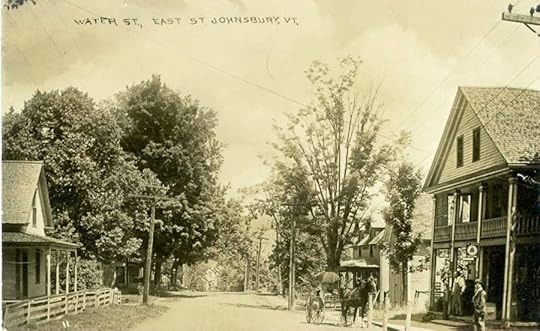 It's that time of year. Snow filters onto the back field. Birds visit the feeders. Deer leave tracks at night. And I start a new book.
It's that time of year. Snow filters onto the back field. Birds visit the feeders. Deer leave tracks at night. And I start a new book.Except. Gulp. This time I'm starting three of them. It can't be helped. They are all whispering to me and the time to get the words into place is NOW.
The one I want to talk about today doesn't have a title yet. As I've worked on the research over the past few years, I've just called it "the Lyndonville (Vermont) mystery." But a few weeks ago the main character suddenly waltzed into my life and I had to start ... her name is Almyra, and she's 16, in November of 1899, in East St. Johnsbury, Vermont. And yes, the action up ahead will take place in Lyndonville.
People often ask about a writer's "process." Mine has less to do with what time of day I write, and more to do with how I prepare. I do literally years of historical research. Part of the background of Almyra's story is this information sifted from the 1910 version of Walton's Vermont Register:
In Lyndon, millinery, Mrs. E. M. Swett; in Lyndon Center, none; in Lyndonville, tailor, J. C. Stevens; clothing and gents' furnishings, S. Stern; millinery, Mrs. E. Bigelow, Mrs. F. J. Willey, Mrs. H. Duston, Mrs. W. Barber.But I also prepare in "five or six senses," and this time one of the necessary elements is a necklace of amber beads. Amber isn't a stone -- it's a fossilized resin. And amber comes particularly from the Baltic (those now-reappearing nations of Latvia, Lithuania, and Estonia -- which have sometimes been part of Russia), but there is also a noted deposit of amber in Kansas, the state where so many pro-Abolition Vermonters made their homes in the mid 1800s to try to sway the new territory toward becoming a "free state."
So, here I am, happily at work, with an amber necklace in place. I love the variety of colors in it. Even more, I am enjoying knowing the role that amber will play in Almyra's story.
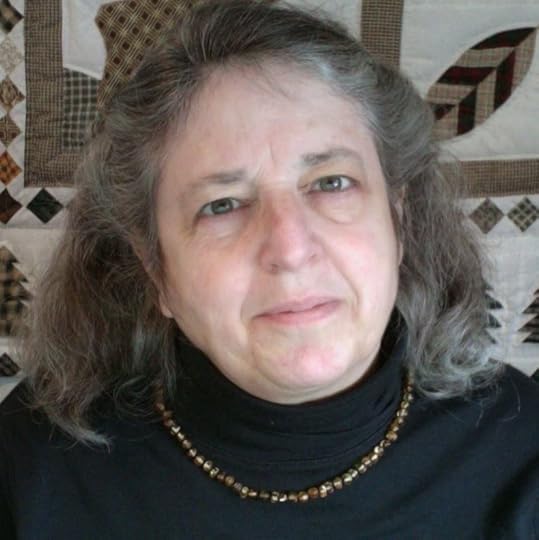 Last bit of process: I've purchased paperback copies of two books (well, one is a 10-book series, repackaged in one volume) that I enjoyed reading years ago, and in their titles is the word "Amber."
Last bit of process: I've purchased paperback copies of two books (well, one is a 10-book series, repackaged in one volume) that I enjoyed reading years ago, and in their titles is the word "Amber." CONTEST!! To the first person who can correctly guess BOTH the book titles (for the series, you can either name the first book OR the series, but you have to also name the other book), and place them here as a comment, I will mail a signed copy of my most recent mystery, Cold Midnight. Looking forward to your replies.
Published on November 16, 2014 09:10
November 2, 2014
ALWAYS Read the Book Before the Movie ...
This is a rule I learned from my parents when I was a kid. Why do it this way? Because you get to have your own images of the characters, savor the plot without being pushed by the music (or, even worse, laugh track), and know much more in detail than the film will ever be able to tell you.
But that said, I've been laughing at myself as I realized that on top of all the book release dates I'm watching for, I'm also excited about three movies in the next few weeks based on books that I love.

November 21, first half of the third (last) book in the Hunger Games trilogy from Suzanne Collins. (And now, the final performance by Philip Seymour Hoffman; what a heartbreak.)
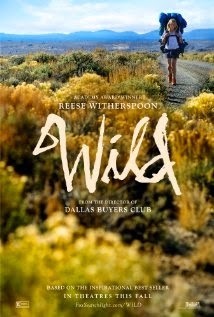
December 5, the real-life adventure that Oprah's Book Club pulled into bestseller land ... and I could not put the book down, WILD by Cheryl Strayed.
 December 17, the final in the three (!) films made from one Tolkien book, THE HOBBIT -- The Battle of the Five Armies -- and by the way, when are we going to see female characters take on quests as powerfully written as Frodo and Sam's?
December 17, the final in the three (!) films made from one Tolkien book, THE HOBBIT -- The Battle of the Five Armies -- and by the way, when are we going to see female characters take on quests as powerfully written as Frodo and Sam's?
What about you? Are you marking your calendar with any books-to-screen adventures this season?
But that said, I've been laughing at myself as I realized that on top of all the book release dates I'm watching for, I'm also excited about three movies in the next few weeks based on books that I love.

November 21, first half of the third (last) book in the Hunger Games trilogy from Suzanne Collins. (And now, the final performance by Philip Seymour Hoffman; what a heartbreak.)

December 5, the real-life adventure that Oprah's Book Club pulled into bestseller land ... and I could not put the book down, WILD by Cheryl Strayed.
 December 17, the final in the three (!) films made from one Tolkien book, THE HOBBIT -- The Battle of the Five Armies -- and by the way, when are we going to see female characters take on quests as powerfully written as Frodo and Sam's?
December 17, the final in the three (!) films made from one Tolkien book, THE HOBBIT -- The Battle of the Five Armies -- and by the way, when are we going to see female characters take on quests as powerfully written as Frodo and Sam's?What about you? Are you marking your calendar with any books-to-screen adventures this season?
Published on November 02, 2014 10:02
November 1, 2014
November: Month of Gray Poems and New Writing Projects
On this first day of November 2014, I'm celebrating -- most especially, the gift of photography that a smartphone makes so accessible. Here is the vista from the end of our road:
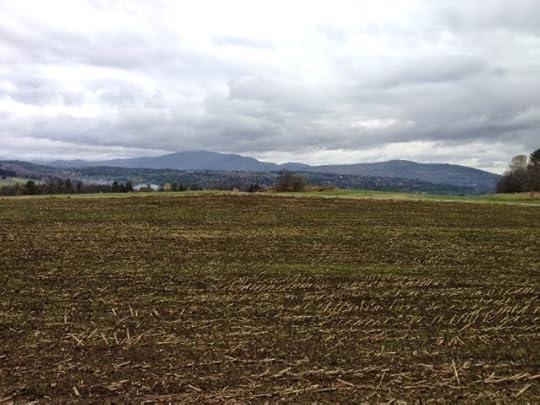
And here is a lovely detail from the little cemetery that I walk past, in order to get there. It's the edge of the stone for George Russell, at the Cushman Cemetery in Waterford, Vermont. I love the detailing, making even the edge of the stone cared for and lovely. I hope Mr. Russell's life felt that way too, at least from time to time.
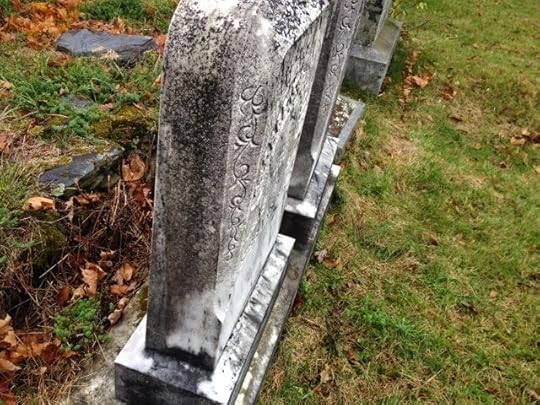
Writers have fresh reason to look forward to November 1, as it's the start of Nanowrimo, a brilliant way to encourage us to start new work and perhaps even finish a first draft by the end of the month. Really! Check out the details at the official website. I haven't signed up on the site (I tried it once but it rubs my introvert nature in the wrong direction!), but I'm starting another adventure novel today, with much exhilaration. I'm happy the outside world is a bit less exciting in this month! (Yes, this means I'm working on two novels, one poetry collection, and one Christmas book this month. And then there's my day job ... and cooking for Dave.)
Finally, for all of us who know tidbits of this poem, the full version from London poet Thomas Hood, dated 1844:
NOVEMBER by Thomas Hood (1799-1845)
No sun - no moon!
No morn - no noon!
No dawn- no dusk - no proper time of day -
No sky- no earthly view -
No distance looking blue -
No road - no street! -
No "t'other side the way" -
No end to any Row -
No indications where the Crescents go -
No top to any steeple -
No recognitions of familiar people -
No courtesies for showing 'em -
No knowing 'em!
No mail - no post -
No news from any foreign coast -
No park - no ring - no afternoon gentility -
No company- no nobility -
No warmth, no cheerfulness, no healthful ease,
No comfortable feel in any member -
No shade, no shine, no butterflies, no bees,
No fruits, no flowers, no leaves, no birds,
November!

And here is a lovely detail from the little cemetery that I walk past, in order to get there. It's the edge of the stone for George Russell, at the Cushman Cemetery in Waterford, Vermont. I love the detailing, making even the edge of the stone cared for and lovely. I hope Mr. Russell's life felt that way too, at least from time to time.

Writers have fresh reason to look forward to November 1, as it's the start of Nanowrimo, a brilliant way to encourage us to start new work and perhaps even finish a first draft by the end of the month. Really! Check out the details at the official website. I haven't signed up on the site (I tried it once but it rubs my introvert nature in the wrong direction!), but I'm starting another adventure novel today, with much exhilaration. I'm happy the outside world is a bit less exciting in this month! (Yes, this means I'm working on two novels, one poetry collection, and one Christmas book this month. And then there's my day job ... and cooking for Dave.)
Finally, for all of us who know tidbits of this poem, the full version from London poet Thomas Hood, dated 1844:
NOVEMBER by Thomas Hood (1799-1845)
No sun - no moon!
No morn - no noon!
No dawn- no dusk - no proper time of day -
No sky- no earthly view -
No distance looking blue -
No road - no street! -
No "t'other side the way" -
No end to any Row -
No indications where the Crescents go -
No top to any steeple -
No recognitions of familiar people -
No courtesies for showing 'em -
No knowing 'em!
No mail - no post -
No news from any foreign coast -
No park - no ring - no afternoon gentility -
No company- no nobility -
No warmth, no cheerfulness, no healthful ease,
No comfortable feel in any member -
No shade, no shine, no butterflies, no bees,
No fruits, no flowers, no leaves, no birds,
November!
Published on November 01, 2014 08:49
October 29, 2014
Galway Kinnell: It's the poem ... it's the story ... it's the poet
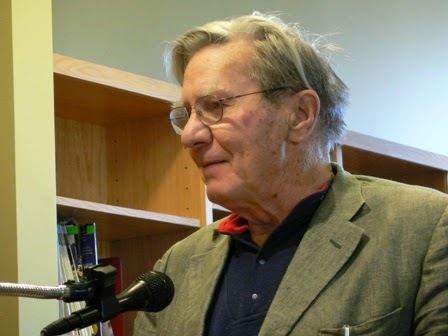
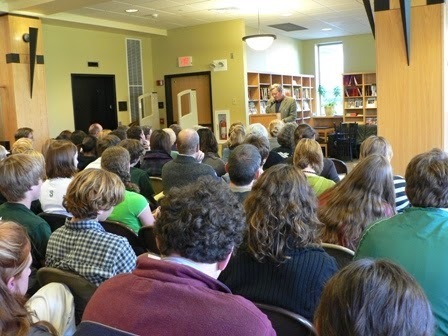
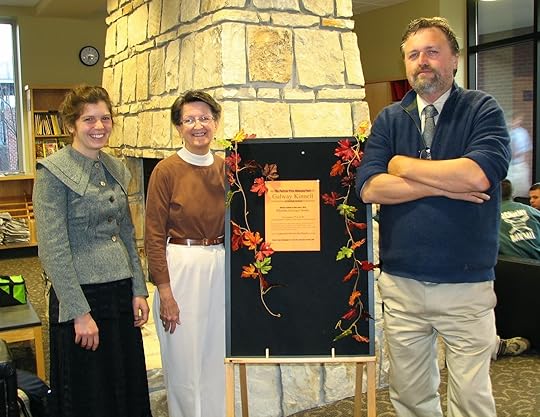
Word online is that our "neighbor" (about 30 miles distant) and gentle friend Galway Kinnell died yesterday -- and since The Poetry Foundation and Wikipedia have already closed his entry with that date, I suppose there is no real chance that the word is wrong.
What a loss ...
These photos (thank you, St J Academy -- were these taken by Denise? Jean?) are from the last time we helped create an event at St. Johnsbury (Vermont) Academy for Galway, in November 2007. He read just five poems -- but braided them together with generous stories about each one that kept the students (and the rest of us) captivated. I learned a lot that day about what it is to care about your audience: the people you write for, and the people you read your poems to.
There will be many longer pieces written in the days to come about this great poet who has left us with such treasures. I wish he could have stayed longer ... and with my husband Dave, we offer sympathy to his family and to his many friends and readers around the world.
If you don't yet know the poems of Galway Kinnell, here's a place to start.
Published on October 29, 2014 10:34
September 19, 2014
Rhymes for Young Ghouls: When Fiction Turns Fierce
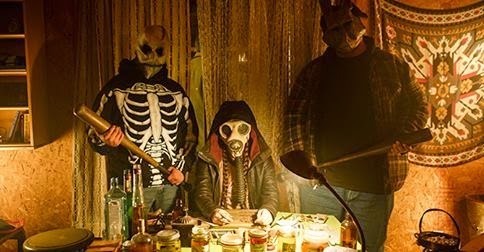 These are "stills" from the Canadian award-winning movie RHYMES FOR YOUNG GHOULS, coming to our local "arts cinema," Catamount Arts, on October 31 (through Nov. 6). The Halloween timing will fit the photo you see above -- but this movie has a lot more to do with Vermont, and my book The Darkness Under the Water, than you might have guessed.
These are "stills" from the Canadian award-winning movie RHYMES FOR YOUNG GHOULS, coming to our local "arts cinema," Catamount Arts, on October 31 (through Nov. 6). The Halloween timing will fit the photo you see above -- but this movie has a lot more to do with Vermont, and my book The Darkness Under the Water, than you might have guessed.Discovering the horrors of Vermont's home-grown eugenics project, which targeted Vermonters of Abenaki (Native American) heritage in the 1930s, pushed me to write The Darkness Under the Water. What was difficult for me to confront -- the betrayal and medical crippling inflicted by our own mostly fair-minded state -- remains much more terrible and present for those whose families suffered in person from this. It was also the reason Vermont's tribal presence became silenced for decades. Census takers in 1980 recorded the state as "empty" of Native Americans; in 1990, when some measure of safety had been restored, so people could answer more honestly, the Census takers (naive!) asked, "Where did all these Native Americans come from all of a sudden?!"
Back to the movie: Filmmaker Jeff Barnaby confronts the parallel racism and oppression that were taking place in Canada, with a very up-to-date and eerily believable "revenge fantasy" film, as a pot-dealing "native" teen takes aim at the Indian Act and the local Indian agent who is threatening to place her in a residential school. If you like your history served up current, with a generous dash of dark humor and good performance, this could be your film. I know it's one I'm going to see (with thanks to Mr. Aldredge at Catamount for the effort of bringing it through the international network).
And if it makes you angry in the long run, about the treatment of Canada's "First Peoples" and our own -- I'll be glad.
Trailer here.
Globe and Mail review here.
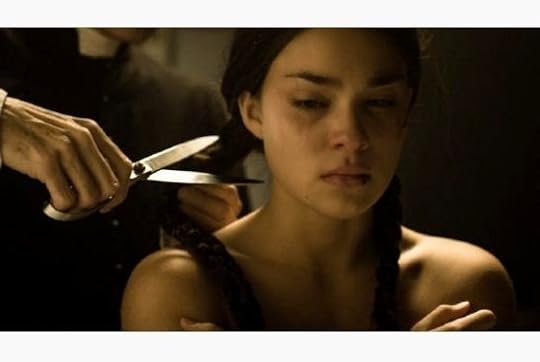
Published on September 19, 2014 08:38
September 14, 2014
A Visit to the Library -- by Five of Us! Are You Coming, Too?
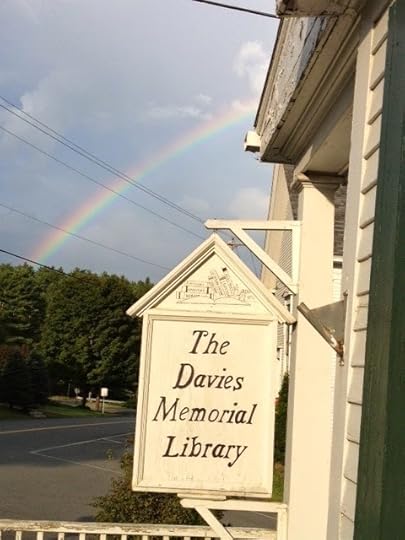 Sometimes Vermont is a very, very small state. Vermont authors run into each other often -- at tea or coffee, or online, or at the library or the town clerk's office.
Sometimes Vermont is a very, very small state. Vermont authors run into each other often -- at tea or coffee, or online, or at the library or the town clerk's office.Peacham, Vermont, memoir writer Gary Schoolcraft found the same idea in this that I found at about the same time: Let's get together on purpose.
So, half a dozen of us (changing in number depending who's available when) are jointly providing author events, selling books at yard sales and county fairs, and even marketing online sometimes (Gary has his Green Mountain Books Sales site just warming up).
And this coming week, on Thursday, we'll be at the best library in the state -- well, it's my own town library, so it means a lot to me! -- the lovely Davies Memorial Library in the "White Village" of Lower Waterford, Vermont. (You can learn more about the White Village and other local treasures here: http://waterford-vt-history.blogspot.com.)
Here's the info -- hope you can join us!
Thursday, September 18th at 6:30 pm -- Local Author Round Table
History. Mystery. Nature and the environment. Fiction. Non-fiction. Poetry. All set in our very own backyard! Join us on Thursday, September 18th at 6:30 for a Local Author Round Table!
Authors Gary Schoolcraft, Tanya Sousa, Beth Kanell, Jerry Johnson and Alec Hastings will be on hand to discuss their writing- what, why and how they write followed by a discussion between author and reader alike. Their books will be available at the event- read below for a brief bio of each of our guests. All are welcome- see you there!
Gary Schoolcraft's book "When Kids Were Allowed to Be Kids" is a best-seller in our area. He describes his collection of remembered adventures as "a humorous look at life in the small Vermont town of Peacham during the late ’50′s and all of the ’60′s as seen through the eyes of a kid that was there." He shares snips from the book at his Facebook page, and has a website, http://www.greenmountainbooksales.com.
Tanya Sousa of Coventry is an award-winning author of environmental and agricultural children's books, novels, stories and essays. She specializes in topics focusing on human interaction with other living things/the environment - her most recent work is the ecological novel, "The Starling God", which has received five-star reviews to date from readers from all walks of life and around the country. Readers' comments and more may be found on the publisher's website page for the book: http://www.forestrypressproducts.com/the-starling-god-by-tanya-sousa/.
Beth Kanell of Waterford writes Northeast Kingdom adventure novels, with a touch of both mystery and history. So far, they've been set in North Danville, St. Johnsbury, and Waterford, and this year she finished a Barnet book and a "teen sleuth" book set in Montpelier. She shares her research and writing life at bethkanell.blogspot.com, and visits schools and libraries to tell tales of the true (and often criminal!) history behind her novels.
Jerry Johnson of Craftsbury is a well-published poet whose wish came true when he wrote "Up the Creek Without a Saddle": His dream was fulfilled when Vermont’s legendary master musicians, Jon Gailmor and Pete Sutherland, took 16 of his book’s 99 poems and set them to music. A beautiful CD of their songs comes with the book for free. It is Jerry’s gift back to Vermont, those who love the Green Mountain State, and people anywhere who love the natural world. Jerry’s books and background can be found at his website, www.vtpoet.com.
Alec Hastings just retired from teaching in Bethel, Vermont. To encourage adventurous reading among his students, especially the boys, he wrote the novel "Otter St Onge and the Bootleggers," which he describes as "a rip-snorting tale of Vermont moonshine smugglers during the Flood of '27." His connections to the area include his father's grandparents, who farmed in McIndoe Falls.
Contact the library at 748-4609 or davieslibraryvt@gmail.com for more information.
Published on September 14, 2014 14:20
September 7, 2014
What the Young Squirrel Showed to Me
Walking uphill on our dirt road on Friday, I noticed a very large and long "pinecone" that had been run over -- still mostly attached together, but fringed and shattered along its edges. Ten minutes later, headed back down the hill, I found this very young squirrel digging into it, extracting the protein-rich seeds.
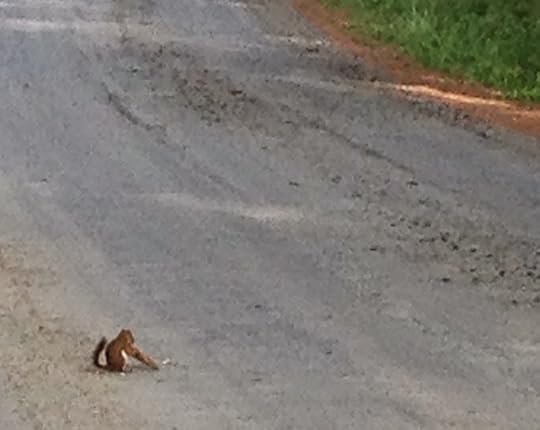
The little squirrel (a red one) stayed on task and let me get closer than most adult squirrels permit. But finally he/she grabbed the biggest chunk of the cone and bounded off into the scrub and woods next to the road.
The squirrel's attention to the cone pushed me to wonder more about it. I looked up the cone today -- and that's why I put the term "pinecone" into quotation marks, as these fibrous seed carriers come on spruces and even birches, not just pines. But it does seem from my Audubon Society Field Guide to be a cone from a white pine.
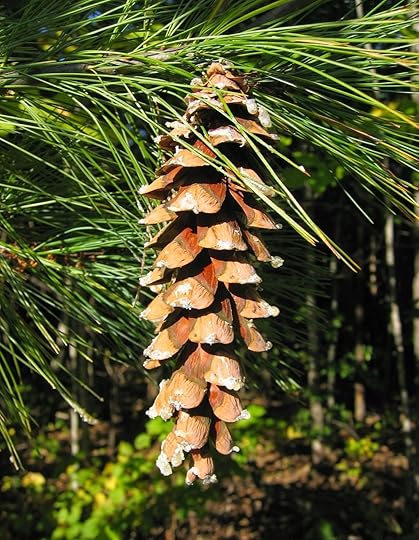
I was really surprised to see the "cones" on birch twigs in the book. All these years admiring birches, and I've never looked at them closely enough to see what carries their seeds! A few pages later are photos of acorns; why didn't I even stop to notice that different kinds of oaks present different shapes and colors of acorns? Guess I was always just pleased to be able to say "oak" and "acorn."
As I look at the neighboring town of Lyndonville with intent to frame a YA mystery there (probably in 1898), I'm finding the same surprise at what I've walked or driven past without questioning, noticing, or naming. Lyndonville suffered two devastating fires in the first part of the 1900s, wiping out one side of its main street, then the other. Yet there are structures that date to 1898 on most of the "town center" streets. And only recently, my husband Dave (who lived in that town for two decades and has a great collection of postcard images of it) and I realized how many portions of the massive railroad complex from, say, 1855 to 1950 linger in town, repurposed or quietly shuttered and overgrown.
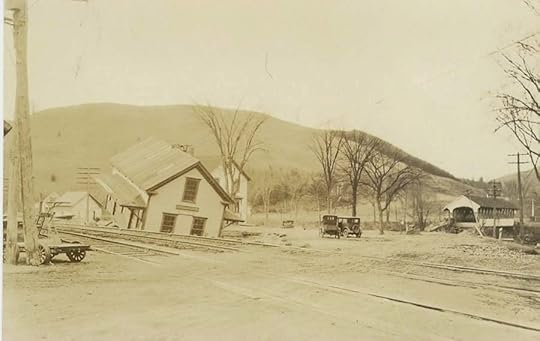
Soon I'll choose names for the teen and the two older women who'll make up the main characters of this book-being-planned. While those details come together, I'll also look around the town for traces that remain of the people I'm envisioning. I've already seen evidence of their lives (the real ones, not my fictional versions) in Census documents and 1890s advertisements. Crafting a good story from these "seeds" means paying attention to the names and existence of what's already there.
Thanks, Red Squirrel. You've got me asking questions and seeking answers. Way to go.

The little squirrel (a red one) stayed on task and let me get closer than most adult squirrels permit. But finally he/she grabbed the biggest chunk of the cone and bounded off into the scrub and woods next to the road.
The squirrel's attention to the cone pushed me to wonder more about it. I looked up the cone today -- and that's why I put the term "pinecone" into quotation marks, as these fibrous seed carriers come on spruces and even birches, not just pines. But it does seem from my Audubon Society Field Guide to be a cone from a white pine.

I was really surprised to see the "cones" on birch twigs in the book. All these years admiring birches, and I've never looked at them closely enough to see what carries their seeds! A few pages later are photos of acorns; why didn't I even stop to notice that different kinds of oaks present different shapes and colors of acorns? Guess I was always just pleased to be able to say "oak" and "acorn."
As I look at the neighboring town of Lyndonville with intent to frame a YA mystery there (probably in 1898), I'm finding the same surprise at what I've walked or driven past without questioning, noticing, or naming. Lyndonville suffered two devastating fires in the first part of the 1900s, wiping out one side of its main street, then the other. Yet there are structures that date to 1898 on most of the "town center" streets. And only recently, my husband Dave (who lived in that town for two decades and has a great collection of postcard images of it) and I realized how many portions of the massive railroad complex from, say, 1855 to 1950 linger in town, repurposed or quietly shuttered and overgrown.

Soon I'll choose names for the teen and the two older women who'll make up the main characters of this book-being-planned. While those details come together, I'll also look around the town for traces that remain of the people I'm envisioning. I've already seen evidence of their lives (the real ones, not my fictional versions) in Census documents and 1890s advertisements. Crafting a good story from these "seeds" means paying attention to the names and existence of what's already there.
Thanks, Red Squirrel. You've got me asking questions and seeking answers. Way to go.
Published on September 07, 2014 07:19
August 30, 2014
Falling in Love Again ... With a Covered Bridge
History may be global -- but I'm convinced the start of a love for history is almost always personal and local. In grades kindergarten through grade 4, I often look for investigation projects that connect with what kids already know: their homes, their neighborhoods.
Now and then, it's also nice to go back to that kind of moment. In the last couple of years, I've become very fond of the Sanborn covered bridge in Lyndonville. It helps, of course, to know that the original bridge owner was a very, very distant cousin of mine (my mom would have been thrilled). But also I find the construction and the bridge's long life satisfying. My next novel (the first draft will start at the end of September) is set in Lyndonville, a mystery of course, and I may have to include the bridge as a symbol of how much easier it is to get along with "things" than with people!
Floods and age have taken a toll, and the bridge is under repair. (You can help save it -- click here.) Here are a couple of recent photos of it -- as well as a postcard that includes it, found by my intrepid researcher husband Dave. Do you think he can bear to share my love with the bridge? (Smile.)
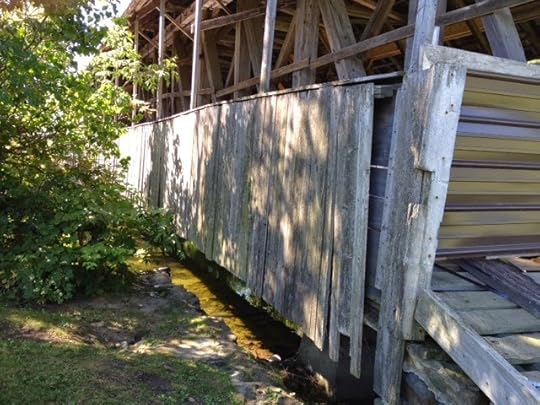
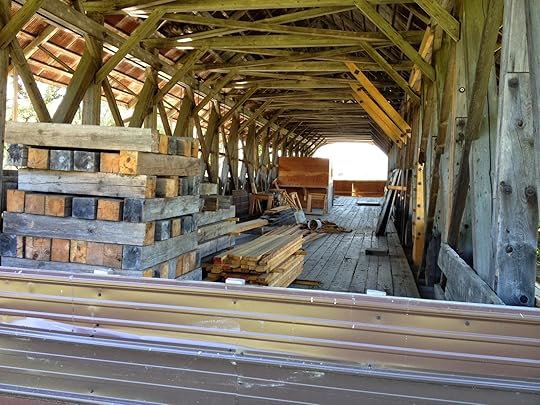
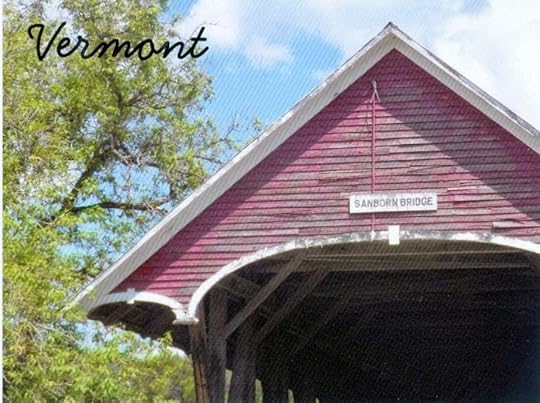
Now and then, it's also nice to go back to that kind of moment. In the last couple of years, I've become very fond of the Sanborn covered bridge in Lyndonville. It helps, of course, to know that the original bridge owner was a very, very distant cousin of mine (my mom would have been thrilled). But also I find the construction and the bridge's long life satisfying. My next novel (the first draft will start at the end of September) is set in Lyndonville, a mystery of course, and I may have to include the bridge as a symbol of how much easier it is to get along with "things" than with people!
Floods and age have taken a toll, and the bridge is under repair. (You can help save it -- click here.) Here are a couple of recent photos of it -- as well as a postcard that includes it, found by my intrepid researcher husband Dave. Do you think he can bear to share my love with the bridge? (Smile.)



Published on August 30, 2014 08:10



